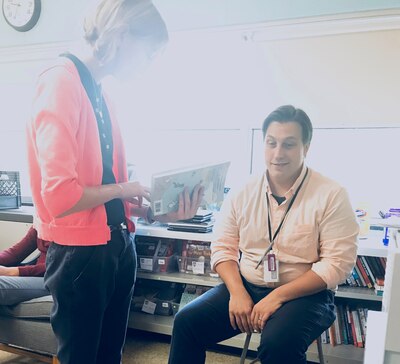How do teachers captivate their students? Welcome to How I Teach, a feature in which we ask great educators how they approach their jobs. Have a recommendation of someone we should profile? Write us at in.tips@chalkbeat.org.
Erik Catellier doesn’t expect perfection from his students. He expects greatness.
That’s why Catellier, a language arts teacher at Center for Inquiry School 2, also wants students and their families to know about his own challenges: He is dyslexic.
“I have never been able to be the sage on the stage, all-knowing teacher,” Catellier, known to students as Mr. Cat, told Chalkbeat. “I am upfront and honest with my students and my families about my struggles as a learner. I have the fact that I am dyslexic in my email signature.”
Catellier was diagnosed with dyslexia in first grade. Dyslexia is a learning disorder affecting a person’s ability to read and spell.
Growing up, the setback pushed him to learn how to manage his own learning style and establish strategies to be successful. With the help of his own teachers, Catellier was able to understand class material and was reassured that he was a capable student.
That’s what inspired Catellier to help his own students discover their own capabilities.
“In the end, I had a lot of adults in my life that believed in me and made me feel valuable. I found that I wanted to be that for others,” he said. “These experiences planted the idea of teaching as a noble profession in my mind.”
Catellier gives the credit to his learning disability for his ability to adapt to a variety of learning styles and skill levels while also building relationships with students.
This interview has been condensed and lightly edited.
Was there a moment when you decided to become a teacher?

I don’t really remember a single moment where I decided I wanted to become a teacher. It is just something that I have always felt called to do. When I was very young, I really struggled in school. It took me a long time to figure out how to manage my brain and to establish strategies that would allow me to be successful. I was supported by some amazing teachers who took time out of their day to help me understand not only the material in their class but that I was a capable student and that I was cared for.
In high school, I taught swim lessons and found that I had a talent for helping students overcome their fears in the water and master new skills. I also discovered how amazing it felt when a student mastered a new skill and would swim across the pool for the first time, or jump off the diving board.
I realized that I had created a situation where that young person could do something they never thought they could. Just like those teachers supported me and helped me see that there was nothing I couldn’t do, I just had to figure out a way that would work for me. In the end, I had a lot of adults in my life that believed in me and made me feel valuable and I found that I wanted to be that for others.
What challenges come with being a language arts teacher with dyslexia?
There are some challenges to being a language arts teacher with dyslexia — usually these always have to do with communication. More and more, the preferred method of communication between school and home is through written communication like emails, newsletters, and text messages. At my school, we even have narrative report cards requiring me to write a paragraph for each student.
My biggest struggle is with editing my own writing. I can’t see simple errors like “from” versus “form,” or “her” versus “here.” But you can imagine receiving an email or report card from your student’s English teacher riddled with little errors does not inspire confidence. I have to go through a lot of extra steps when composing written communications.
What strategies do you use in the classroom to handle your dyslexia?
These steps have been refined over the years as technology has improved, but now every document I write goes through a three-step process. First, I use spell check to catch any simple errors. Second, I use Grammarly to find any mistakes that spellcheck might have missed. Third, I cut and paste it into Google Translate and listen to the computer to read the document.
Usually, if I do this, I catch most of the errors in a document. Unfortunately, I have not found a way to always have enough time to go through this process for everything I create.
How has dyslexia affected you as a teacher?
Whenever I got it into my head that I was some brilliant teacher and tried to control a class-based solely on my encyclopedic knowledge of the English language, I would make some silly error, and all the students would laugh, and the bubble would pop. Instead I had to show students how much I loved the content of the class and that I am always learning and growing, as well. This subject is hard for me as well sometimes, and so we often need to work together to do our best work.
How do you get to know your students?
As a language arts teacher and the “book dealer” of my building, I use books to get to know my students. I talk to my students about what they like to read, and what they don’t like to read. I ask them what their favorite books are, and I share mine with them. I suggest other books I think they might like, and all the time I am getting to know them. You would be surprised how much you can learn about a person when you talk to them about a book that they love.
What are you reading for enjoyment?
I just finished “Tuck Everlasting” by Natalie Babbitt, and I am starting “Dread Nation” by Justina Ireland.
Tell us about a favorite lesson to teach. Where did the idea come from?
Every year in the fall, my eighth-graders do a unit on banned and challenged books. Students use the American Library Association’s list of the most banned books to select a book they would like to read and then spend the quarter reading and analyzing it. The unit culminates in students making the case that their book should or should not be allowed in a public library.
I love this unit because, as a teacher, it contains all of my favorite things. It gives students choice in what they read and how they express their ideas, and it has a final product that is very connected with something people actually do. I also love the fact that I “trick” students into reading classic novels, like “Catch-22” or “Catcher in the Rye.”
What object would you be helpless without during the school day?
I would be helpless without my daily PowerPoints. I have even been known to insert video clips of myself giving instructions when I am absent so students know what to do. The students call them “The Mr. Cat Vlogs.”
Tell us about a memorable time — good or bad — when contact with a student’s family changed your perspective or approach.
My principal always says, “Our parents send us the best kid they can every day.” I have worked really hard to remember that. No matter what a student’s circumstance, it is my job to be the best teacher I can be and to support them in every way I can. Often times school is the only place where a student feels seen and cared about. I think it is important to remember this and to try to be the kind of adult the students need and that they can count on.


